
Famine in Russia, 1921-1923. Zaporoshré. Child driven by starvation to cannibalis.
Holodomor
The Holodomor “to kill by starvation” was a man-made famine in Soviet Ukraine in 1932 and 1933 that starved to death twelve million ethnic Ukrainians. The Holodomor has been recognised by Ukraine and fifteen countries as genocide carried out by the Soviet government.
“You must understand. The leading Bolsheviks who took over Russia were not Russians. They hated the Russians. They hated Christians. Driven by ethnic hatred, they tortured and slaughtered millions of Russians without a shred of human remorse. The October Revolution was not what you call in America the “Russian Revolution.” It was an invasion and conquest over the Russian people. More of my countrymen suffered horrific crimes at their bloodstained hands than any people or nation ever suffered in the entirety of human history. It cannot be understated. Bolshevism was the greatest human slaughter of all time. The fact that most of the world is ignorant of this reality is proof that the global media itself is in the hands of the perpetrators.”.
The word Holodomor translated from Ukrainian means “death by hunger”, or “killing by hunger, killing by starvation”, or sometimes “murder by hunger or starvation”. It is a compound of the Ukrainian words holod “hunger” and mor “plague”. The expression moryty holodom means “to inflict death by hunger”. The Ukrainian verb moryty (морити) means “to poison, to drive to exhaustion, or to torment”.
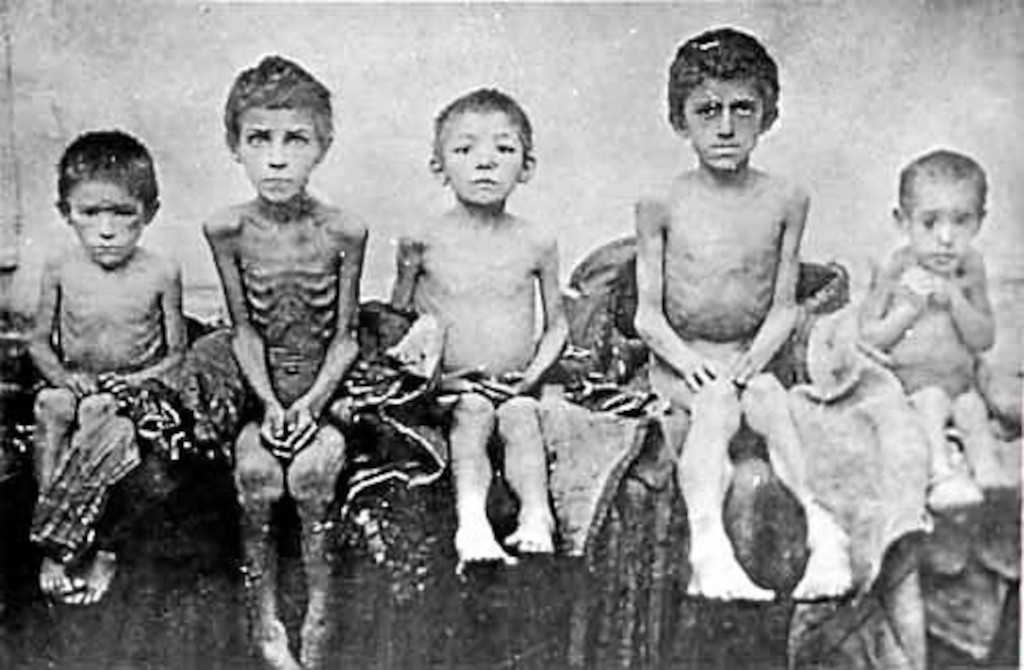
“You are starving? This is not famine yet! When your women start eating their children, then you may come and say we are starving”.
The perfective form of moryty is zamoryty — “kill or drive to death by hunger, exhausting work”. “Holodomor” is now an entry in the modern, two-volume dictionary of the Ukrainian language, published in 2004. The term is described as “artificial hunger, organised on a vast scale by a criminal regime against a country's population.”.
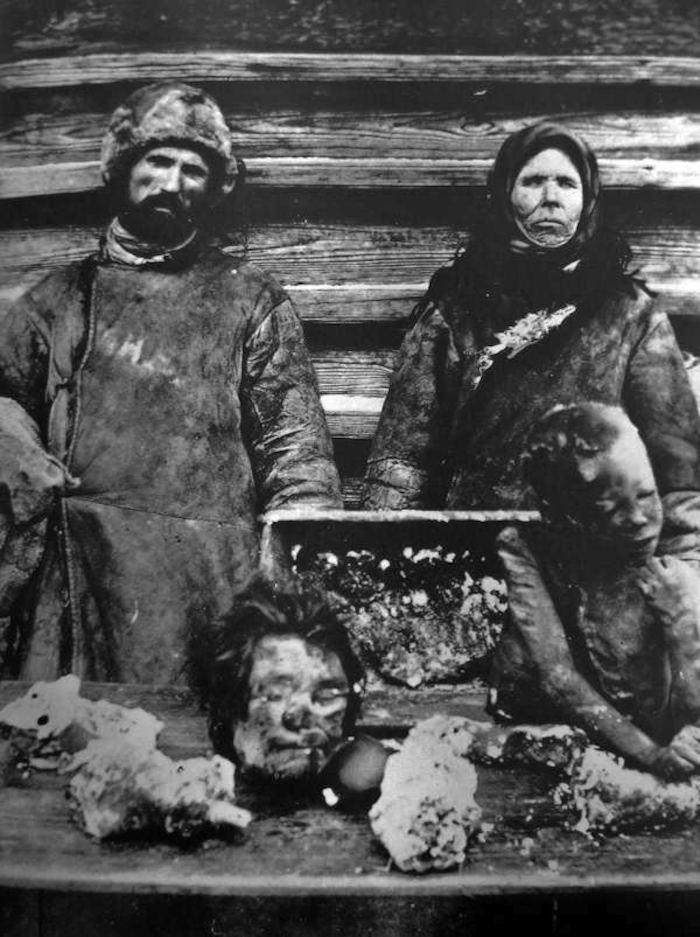
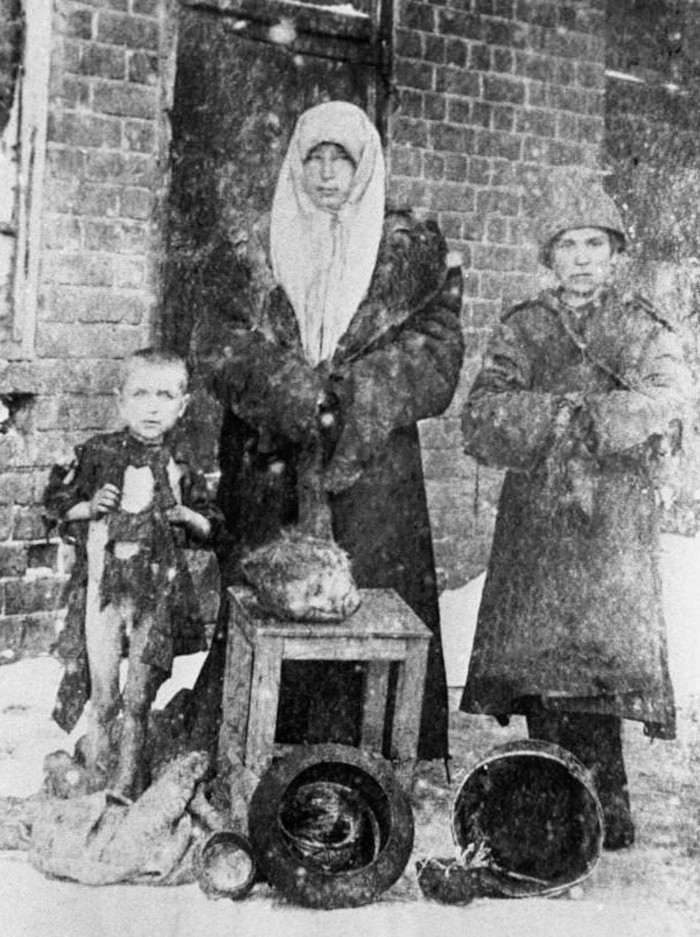
“Survival was a moral as well as a physical struggle. A woman doctor wrote to a friend in June 1933 that she had not yet become a cannibal, but was “not sure that I shall not be one by the time my letter reaches you.” The good people died first. Those who refused to steal or to prostitute themselves died. Those who gave food to others died. Those who refused to eat corpses died. Those who refused to kill their fellow man died. Parents who resisted cannibalism died before their children did.”.
The first five-year plan changed the output expected from Ukrainian farms, from the familiar crop of grain to unfamiliar crops like sugar beets and cotton. Also, the situation was exacerbated by poor administration of the plan and the lack of relevant general management. Significant amounts of grain remained unharvested, and — even when harvested — a significant percentage was lost during processing, transportation, or storage. In the summer of 1930, the government instituted a program of food requisitioning, ostensibly to increase grain exports. Subsequently, in 1932, food theft was made punishable by death or 10 years imprisonment.
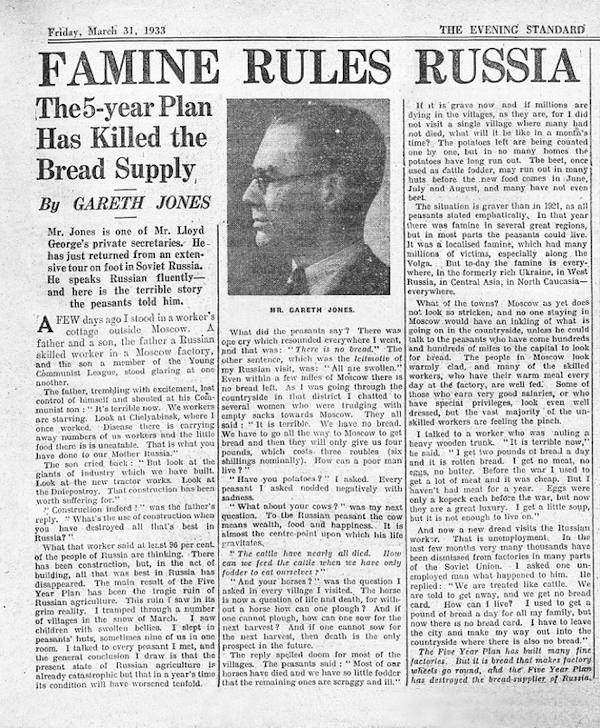
The first reports of mass malnutrition and deaths from starvation emerged from two urban areas of the city of Uman, reported in January 1933 by Vinnytsia and Kiev oblasts. By mid-January 1933, there were reports about mass “difficulties” with food in urban areas, which had been undersupplied through the rationing system, and deaths from starvation among people who were refused rations, according to the Ukraine Central Committee's Decree of December 1932.
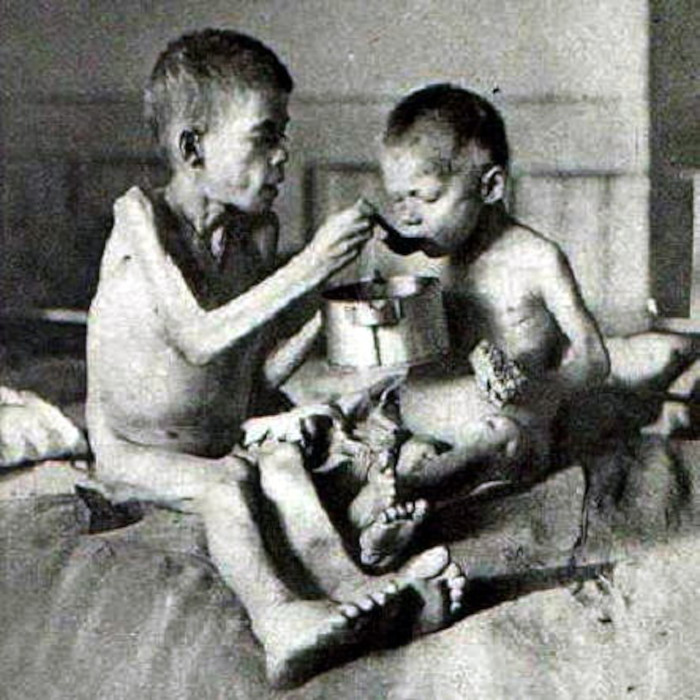
By the beginning of February 1933, according to reports from local authorities and Ukrainian GPU, the most affected area was Dnipropetrovsk Oblast, which also suffered from epidemics of typhus and malaria. Odessa and Kiev oblasts were second and third, respectively. By mid-March, most of the reports of starvation originated from Kiev Oblast.
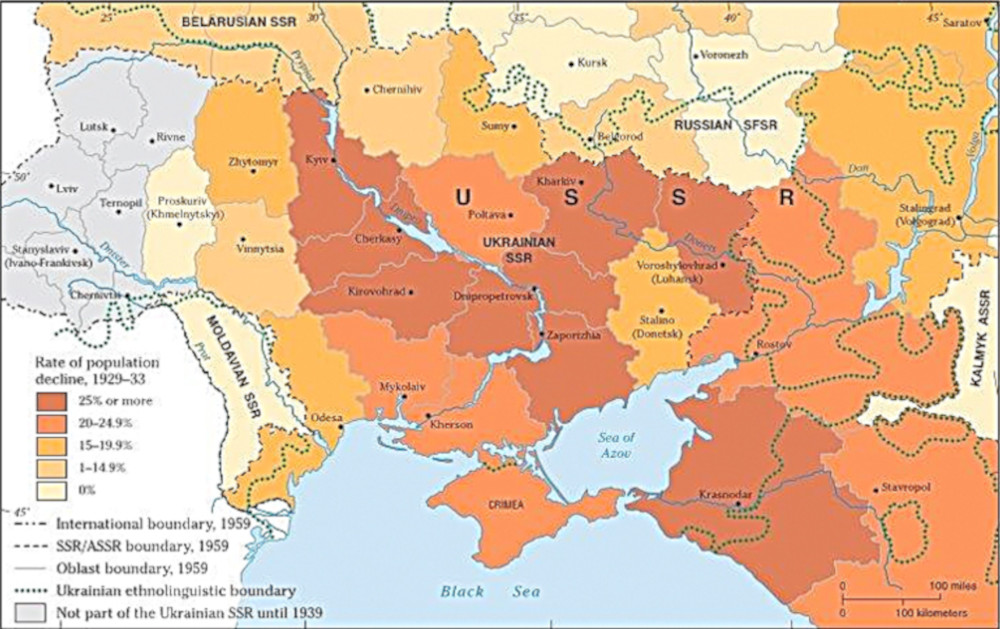
By mid-April 1933, Kharkiv Oblast reached the top of the most affected list, while Kiev, Dnipropetrovsk, Odessa, Vinnytsia, and Donetsk oblasts, and Moldavian SSR were next on the list. Reports about mass deaths from starvation, dated mid-May through the beginning of June 1933, originated from raions in Kiev and Kharkiv oblasts.
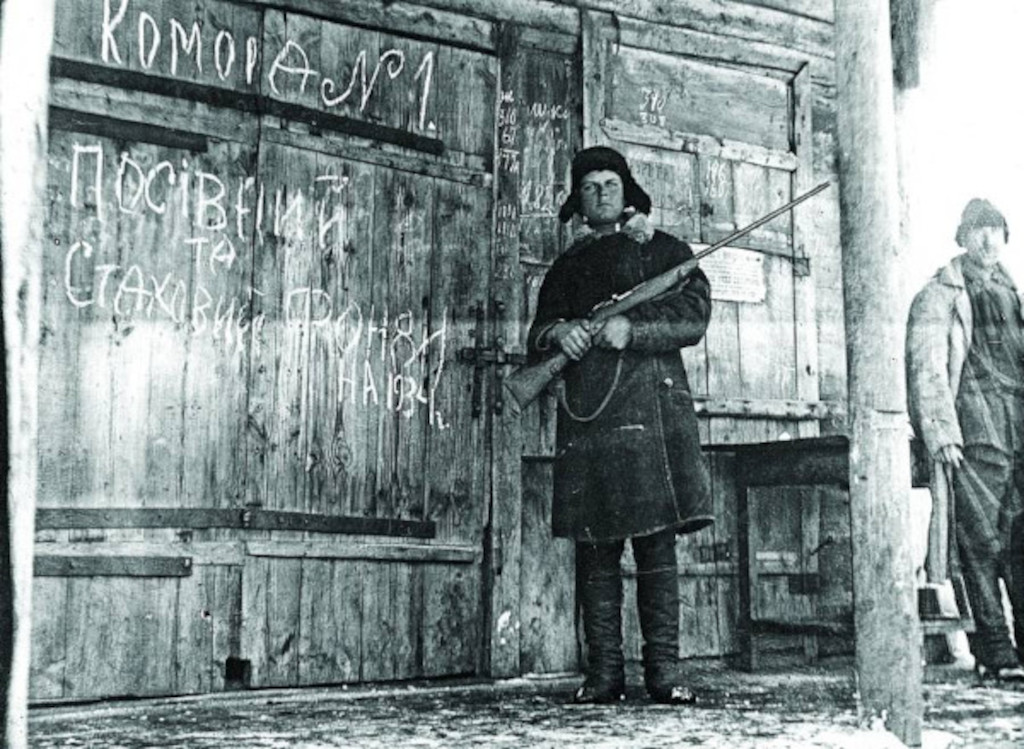
“I’m asking for your permission to advance me any amount of grain. I’m completely sick. I don’t have any food. I’ve started to swell up, and I can hardly move my feet. Please don’t refuse me, or it will be too late”.
Special and particularly lethal policies were adopted in and largely limited to Soviet Ukraine at the end of 1932 and 1933. According to Snyder: “Each of them may seem like an anodyne administrative measure, and each of them was certainly presented as such at the time, and yet each had to kill.” Under the collectivism policy, for example, farmers were not only deprived of their properties, but a large swath of these was also exiled to Siberia with no means of survival. Those who were left behind and attempted to escape the zones of famine were ordered shot. Some foreign individuals witnessed this atrocity or its effects. For example, there was the account of Arthur Koestler, a Hungarian-British journalist, which described the peak years of Holodomor in these words:
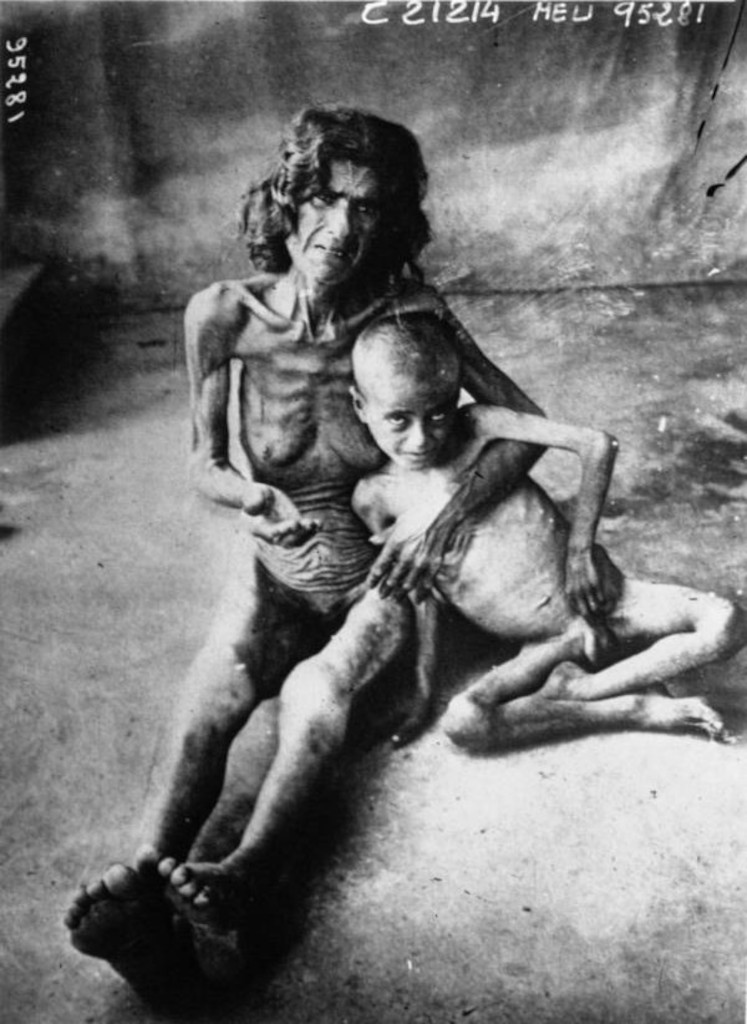
“At every train station, there was a crowd of peasants in rags, offering ikons and linen in exchange against a loaf of bread. The women were lifting up their infants to the compartment windows — infants pitiful and terrifying with limbs like sticks, puffed bellies, big cadaverous heads lolling on thin necks”.
By the end of 1933 million people had starved to death or otherwise died unnaturally in the Soviet republics. Total population loss (including stillbirth) across the union was estimated at 6–7 million. The Soviet Union long denied that the famine had taken place. The NKVD (and later KGB) controlled the archives for the Holodomor period and made relevant records available very slowly. The exact number of the victims remains unknown and is probably impossible to estimate, even within a margin of error of a hundred thousand.
“What I saw that morning … was inexpressibly horrible. On a battlefield men die quickly, they fight back … Here I saw people dying in solitude by slow degrees, dying hideously, without the excuse of sacrifice for a cause. They had been trapped and left to starve, each in his own home, by a political decision made in a far-off capital around conference and banquet tables. There was not even the consolation of inevitability to relieve the horror.”.
Holodomor denial is the assertion that the 1932–1933 genocide in Soviet Ukraine either did not occur or did occur but was not a premeditated act. Denying the existence of the famine was the Soviet state's position and reflected in both Soviet propaganda and the work of some Western journalists and intellectuals including George Bernard Shaw, Walter Duranty, and Louis Fischer. In the Soviet Union, authorities all but banned discussion of the famine, and Ukrainian historian Stanislav Kulchytsky stated the Soviet government ordered him to falsify his findings and depict the famine as an unavoidable natural disaster, to absolve the Communist Party and uphold the legacy of Stalin.

“In 1933, the Russian Foreign Ministry began requiring correspondents to submit a proposed itinerary before any journey into the provinces; all requests to visit Ukraine were refused. The censors also began to monitor dispatches. Some phrases were allowed: “acute food shortage,” “food stringency,” “food deficit,” “diseases due to malnutrition,” but nothing else”.
Duranty was The New York Times correspondent in Moscow from 1922 until 1936, a role that, for a time, made him relatively rich and famous. Duranty reporting was enormously useful to the regime, which went out of its way to ensure that Duranty lived well in Moscow. He had a large flat, kept a car and a mistress, had the best access of any correspondent, and twice received coveted interviews with Stalin. His missives from Moscow made him one of the most influential journalists of his time. In 1932, his series of articles on the successes of collectivisation and the Five-Year Plan won him the Pulitzer Prize.
Under the title “Russians Hungry, But Not Starving” Duranty's article described the situation as follows:
“In the middle of the diplomatic duel between Great Britain and the Soviet Union over the accused British engineers, there appears from a British source a big scare story in the American press about famine in the Soviet Union, with “thousands already dead and millions menaced by death from starvation”.
Five months later (23 August 1933), in another New York Times article, Duranty wrote:
“Any report of a famine in Russia is today an exaggeration or malignant propaganda. The food shortage, however, which has affected the whole population in the last year and particularly in the grain-producing provinces — the Ukraine, North Caucasus, i.e., Kuban Region, and the Lower Volga — has, however, caused heavy loss of life”.
Duranty concluded, “it is conservative to suppose” that, in certain provinces with a total population of over 40 million, mortality had “at least trebled.” The duel in the press over the famine stories did not damage esteem for Duranty. The Nation then described his reporting as “the most enlightened, dispassionate dispatches from a great nation in the making which appeared in any newspaper in the world.”Following sensitive negotiations in November 1933 that resulted in the establishment of relations between the U.S. and the U.S.S.R., a dinner was given for Soviet Foreign Minister Maxim Litvinov in New York City's Waldorf-Astoria Hotel. Each of the attendees' names was read in turn, politely applauded by the guests, until Duranty's. Whereupon, Alexander Woollcott wrote:
“the one really prolonged pandemonium was evoked … Indeed, one quite got the impression that America, in a spasm of discernment, was recognising both Russia and Walter Duranty” With that, the cover-up seemed complete…
Sally J. Taylor, author of the critical Duranty biography Stalin's Apologist, argues that his reporting from the USSR was a key factor in U.S. President Franklin D. Roosevelt's 1933 decision to grant official recognition to the Soviet Union. In 1934, Duranty left Moscow and visited the White House in the company of Soviet officials, including Litvinov. He continued as a Special Correspondent for The New York Times until 1940. Duranty wrote several books on the Soviet Union after 1940. His name was on a list maintained by writer George Orwell of those Orwell considered to be unsuitable as possible writers for the British Foreign Office's Information Research Department, owing to the possibility of them being too sympathetic to communism or possibly paid communist agents.
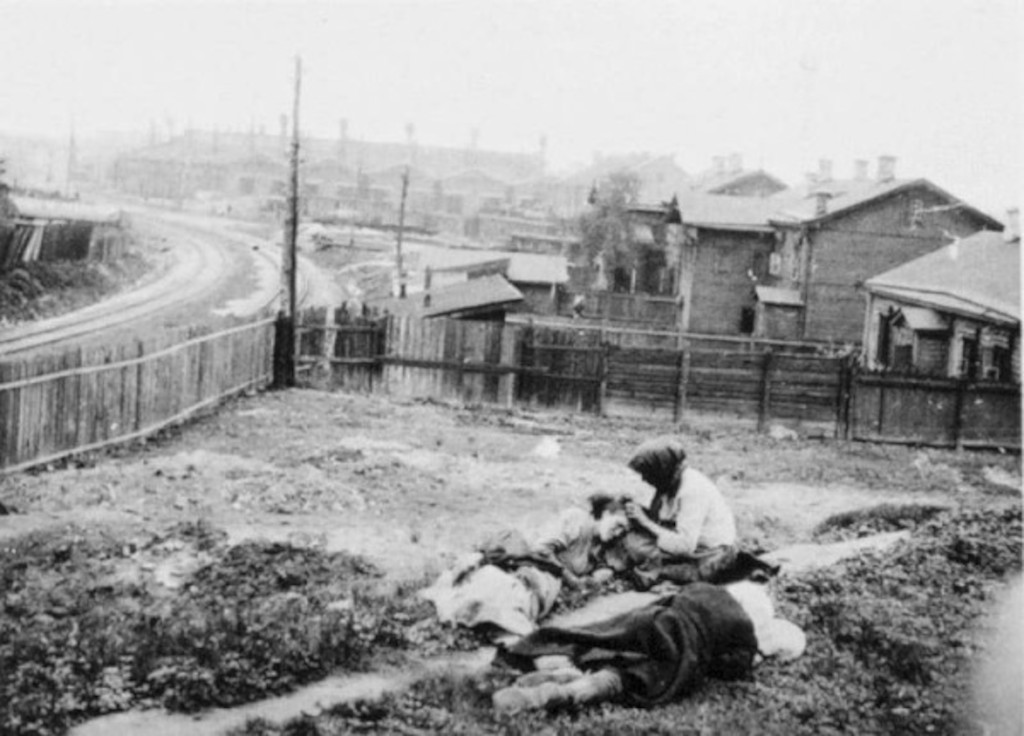
It was clear, meanwhile, from Duranty's comments to others that he was fully aware of the scale of the calamity. In 1934, he privately reported to the British embassy in Moscow that as many as 10 million people may have died, directly or indirectly, from famine in the Soviet Union in the previous year. Both British intelligence and American engineer Zara Witkin (1900–1940), who worked in the USSR from 1932 to 1934, confirmed that Duranty knowingly misrepresented information about the nature and scale of the famine. There are some indications that Duranty's deliberate misdirection concerning the famine may have been the result of duress. Conquest believed Duranty was being blackmailed over his sexual proclivities.
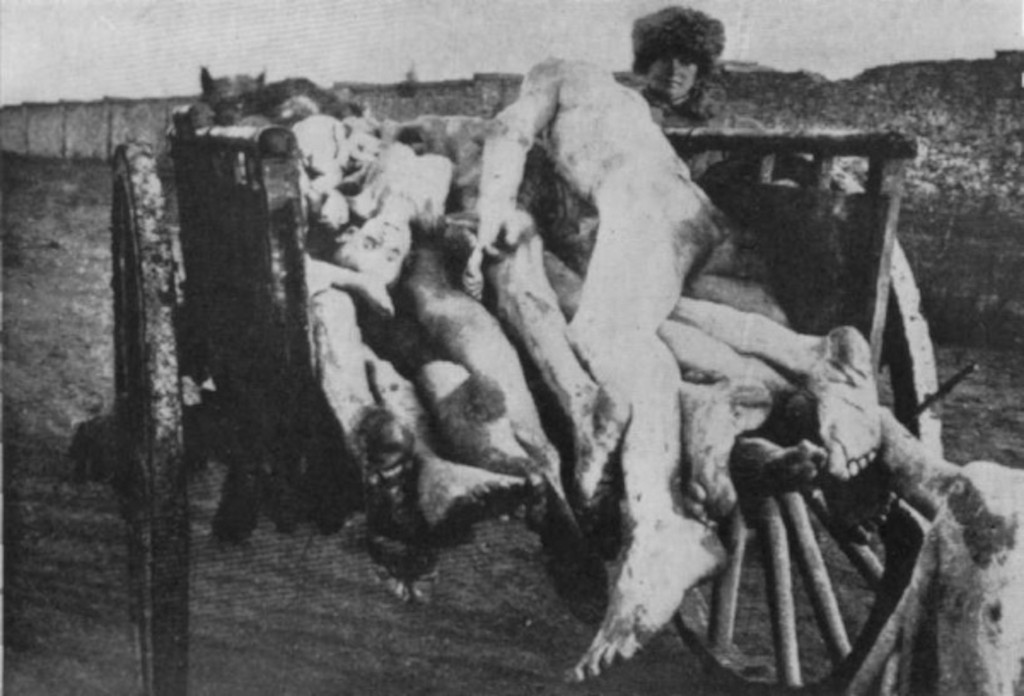
“Communism starved Citizens of the Ukraine out of existence, with collectivised hunger.”.
In his 1944 book, Duranty wrote in a chastened tone about his 1932–34 reporting, but he offered only a Stalinist defence of it. He admits that people starved, including not just “class enemies” but also loyal communists, but he says that Stalin was forced to order the requisitions to equip the Red Army enough to deter an imminent Japanese invasion (a reprise of the Siberian Intervention of a decade earlier)—in other words, to save the Soviet Union from impending military doom, not because Stalin wanted to collectivise the population at gunpoint, on pain of death. Although Stalin did likely expect a Japanese invasion (expecting foreign attacks all the time), most historians today do not accept the view that it was his sole motivation and that Stalin did not intend any cruel and ruthless political dominance of the Soviet population. Of the notion that Stalin did intend the latter, Duranty said, “What a misconception!”.
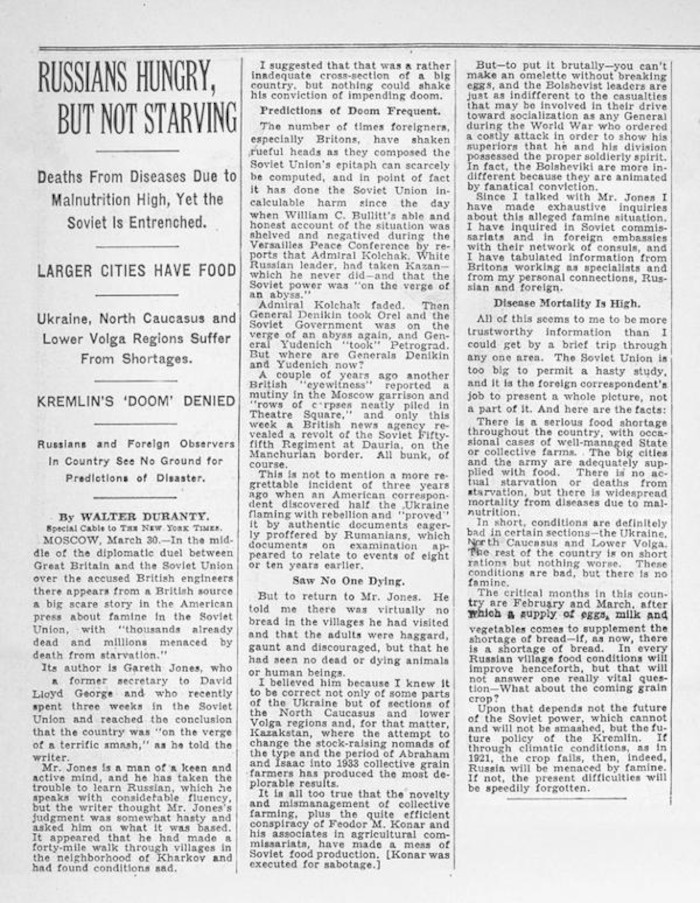
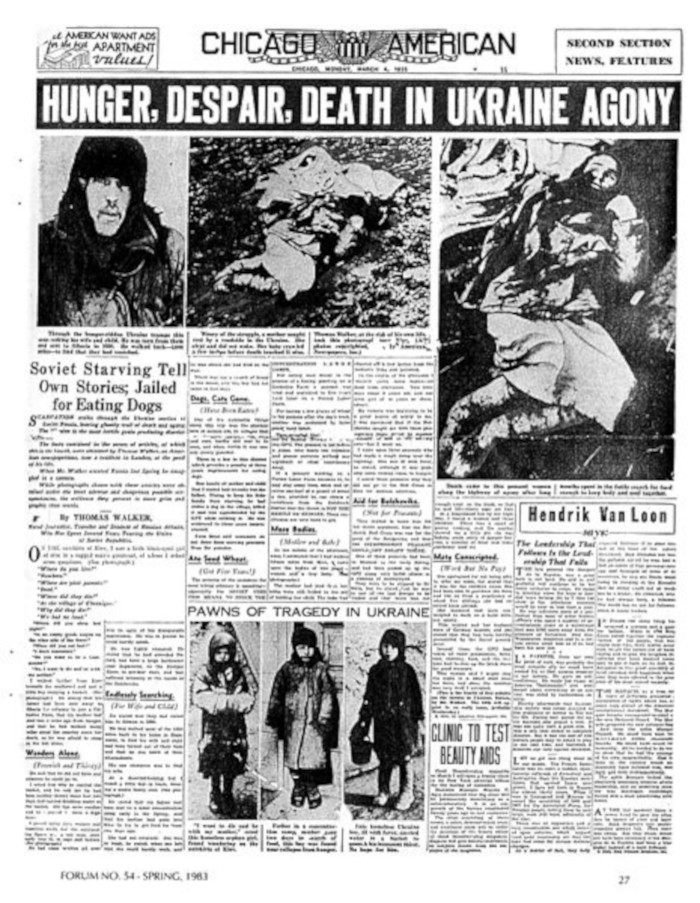
“Without Jews, there would never have been Bolshevism. For a Jew, nothing is more insulting than the truth. The bloodthirsty Jewish terrorist have murdered sixty-six million in Russia from 1918 to 1957.”.
Louis Fischer travelled to Ukraine in October and November 1932, for The Nation, and was alarmed at what he saw. “In the Poltava, Vinnitsa, Podolia and Kiev regions, conditions will be hard,” he wrote, “I think there is no starvation anywhere in Ukraine now — after all they have just gathered in the harvest, but it was a bad harvest.” Initially critical of the Soviet grain procurement program because it created the food problem, Fischer by February 1933 adopted the official Soviet government view, which blamed the problem on Ukrainian counter-revolutionary nationalist “wreckers.” It seemed “whole villages” had been “contaminated” by such men, who had to be deported to “lumbering camps and mining areas in distant agricultural areas which are now just entering upon their pioneering stage.” These steps were forced upon the Kremlin, Fischer wrote, but the Soviets were, nevertheless, learning how to rule wisely.
“It has been proposed that the Soviet leadership used the man-made famine to attack Ukrainian nationalism, and thus again the Holodomor has fallen under the legal definition of genocide”.
A collectivisation policy was enforced in Ukraine, entailing extreme crisis and contributing to the famine. In 1929–30, peasants were induced to transfer land and livestock to state-owned farms, on which they would work as day-labourers for payment in kind. Collectivisation in the Soviet Union, including the Ukrainian SSR, was not popular among the peasantry and forced collectivisation led to numerous peasant revolts.
“Were all people who know one another well, and knew their victims, but in carrying out this task they became dazed, stupefied … They would threaten people with guns, as if they were under a spell, calling small children 'kulak bastards,' screaming 'bloodsuckers!' … They had sold themselves on the idea that so-called 'kulaks' were pariahs, untouchables, vermin. They would not sit down at a 'parasite's' table; the 'kulak' child was loathsome, the young 'kulak' girl was lower than a louse”.
Stalin gave Winston Churchill his estimates of the number of “kulaks” who were repressed for resisting collectivisation as 10 million, in all of the Soviet Union, rather than only in Ukraine. When using this number, Stalin implied that it included not only those who lost their lives, but also those who were forcibly deported.
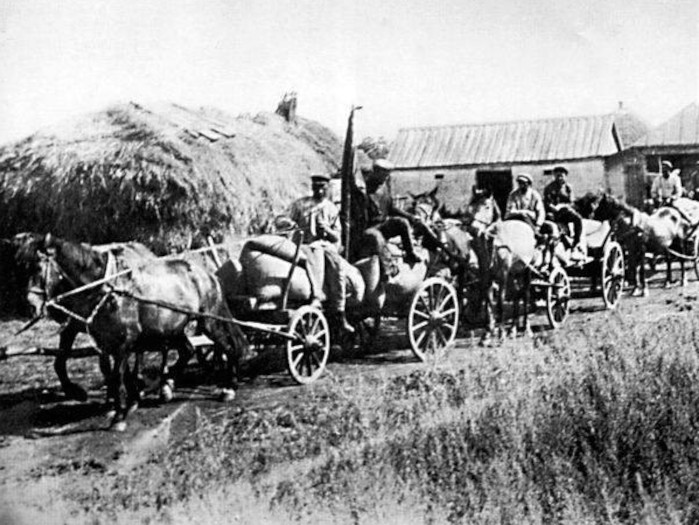
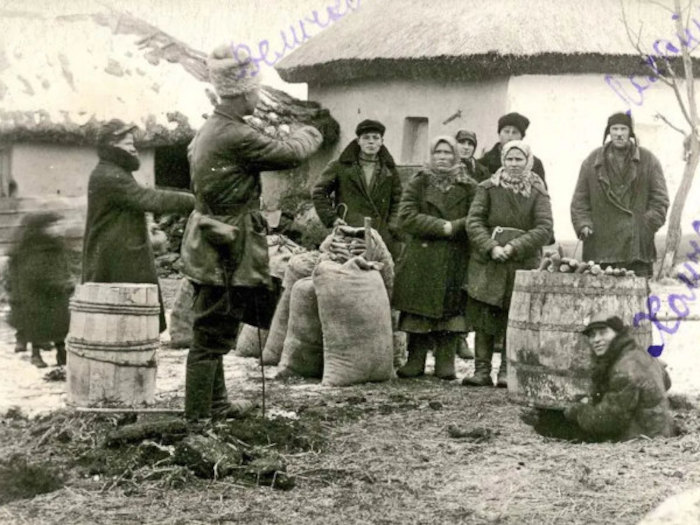
“Wealthy peasants were exiled into Siberia even before Holodomor during the “collectivisation”. Communists came, collected everything. Children were crying, beaten for that with the boots. It is terrifying to recall what happened. It was so dreadful that every day became engraved in my memory. People were lying everywhere as dead flies. The stench was awful. Many of our neighbours and acquaintances from our street died”.
Fischer was on a lecture tour in the United States when Gareth Jones' famine story broke. Speaking to a college audience in Oakland, California, a week later, Fischer stated emphatically: “There is no starvation in Russia.” He spent the spring of 1933 campaigning for American diplomatic recognition of the Soviet Union. As rumours of a famine in the USSR reached American shores, Fischer vociferously denied the reports.
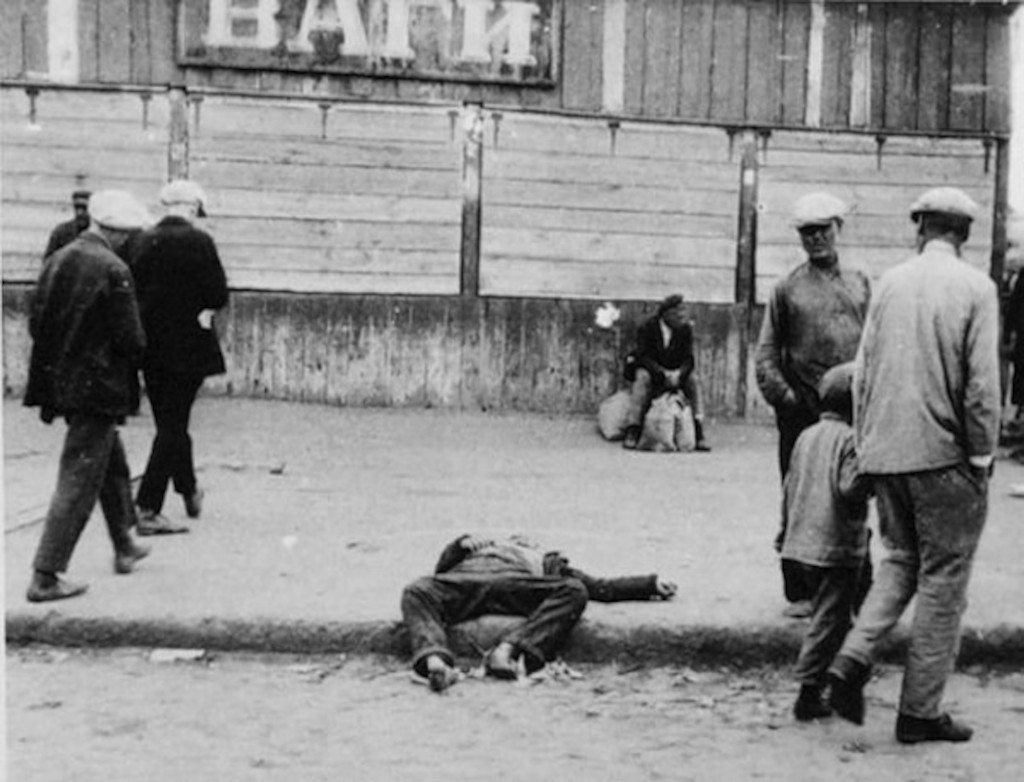
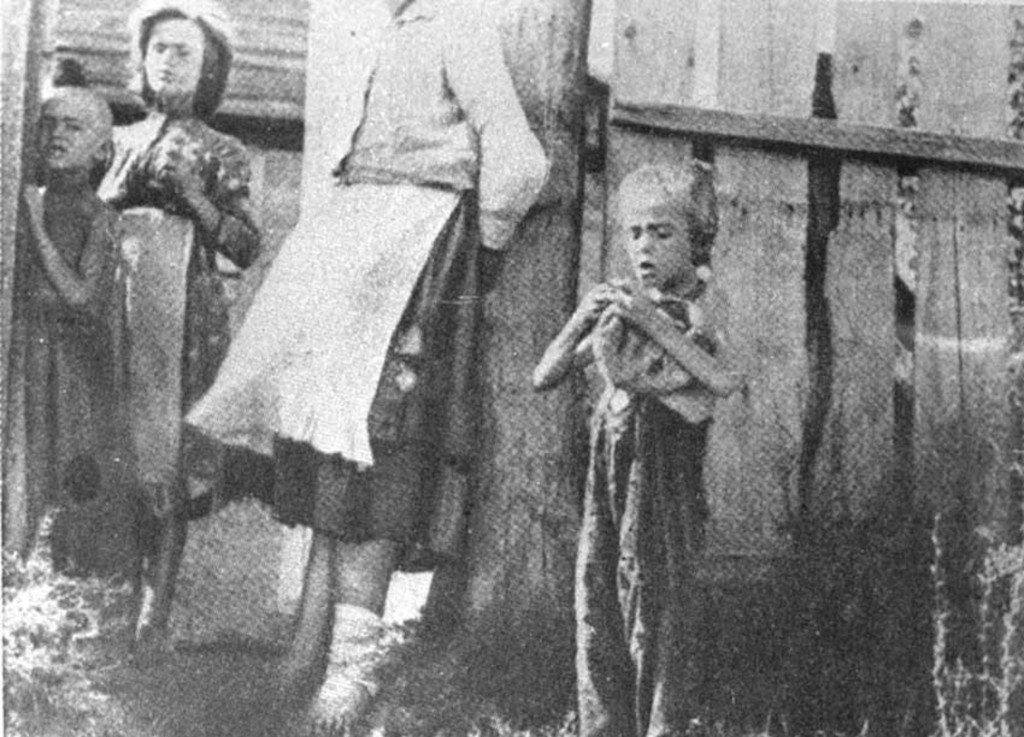
“Everywhere was the cry, “There is no bread. We are dying.” This cry came from every part of Russia, from the Volga, Siberia, White Russia, the North Caucasus, Central Asia “We are waiting for death” was my welcome: “See, we still have our cattle fodder. Go farther south. There they have nothing. Many houses are empty of people already dead,” they cried.
Eugene Lyons, Moscow correspondent for United Press and at one time an enthusiastic Marxist, wrote years later that all of the foreigners in the city were well aware of what was happening in Ukraine as well as Kazakhstan and the Volga region:
“The truth is that we did not seek corroboration for the simple reason that we entertained no doubts on the subject. There are facts too large to require eyewitness confirmation. … Inside Russia, the matter was not disputed. The famine was accepted as a matter of course in our casual conversation at the hotels and in our homes”.
“Censorship has turned them into masters of euphemism and understatement. Hence, they give “famine” the polite name of “food shortage” and “starving to death” is softened down to read as “widespread mortality from diseases due to malnutrition”.